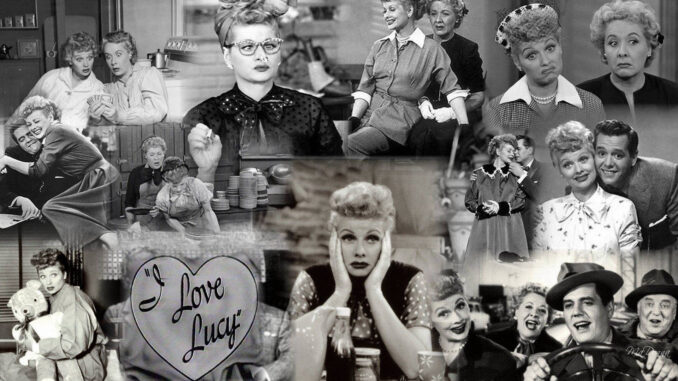
Lucille Ball: We Love Lucy ★★★★
If you only know Lucille Ball from I Love Lucy (for many of us, a mainstay of childhood after-school TV), this 2020 documentary may surprise you.
Ball’s story was a classic rags-to-riches Hollywood tale, but it became so much more. After leaving her Jamestown home for Manhattan, Ball’s career began at 15, with fashion modelling gigs, which led to her first stints as a film extra. By the 1930s she was a contract player for RKO, mostly as a chorus girl before working her way up to lead roles in B movies, where her gift for comedy soon became apparent; she was beautiful, but she was also willing to play the clown. She had steady work in films, alongside stars including Henry Fonda, Judy Garland and Ginger Rogers, but it wasn’t until she landed a gig in radio that she convinced studio bosses, who groomed her to be a movie beauty, that she was a genuine comic talent.
By the time she was starring in CBS radio comedy My Favourite Husband, she was married to Cuban bandleader Desi Arnaz. The pair had a volatile relationship, largely due to Arnaz’s womanising and stints on the road touring. Ball thought My Favourite Husband would adapt well to TV, and if Arnaz starred alongside her, it might even save her marriage. But TV executives, while convinced of her talent, weren’t keen on a leading man who wasn’t white, so Ball, as she would do many times in her career, took matters into her own hands. She and Arnaz took to the road, Arnaz playing with his band and Ball performing her now trademark slapstick comedy. Audiences loved it and I Love Lucy was born, the series that not only made them both superstars, but achieved several television firsts, not least of all that a female star and a Cuban man with an accent were the leads.
The pair also created the sitcom format, shot on film with numerous cameras in front of a live audience. And this was just the beginning: Ball was already 40 when I Love Lucy began (the first television program to reach more than 10 million households). A rarity now, but unprecedented in the 1950s. When she fell pregnant – a word that wasn’t even uttered on television – Ball wrote the pregnancy into the show’s storyline, and the episode where her and Arnaz’s son, Little Ricky, was born attracted 44 million viewers, beating President Dwight Eisenhower’s inauguration, which aired the day before.
And these are just some of Ball’s staggering accomplishments. This 2020 documentary, which coincides with the feature Being the Ricardos on Amazon Prime, focuses on her private life too, but even though her marriage to Arnaz was tabloid fodder at the time, it never descends into the salacious. Everything Ball did in her professional life is far more fascinating anyway; in 1960 she became the first female head of a studio, DesiLu, which produced Star Trek and The Untouchables, among other series.
There are the requisite talking heads – Carol Burnett and Carole Cook, who both worked with Ball, female comedians including Debra Messing and Lily Tomlin, and others who worked with Ball in her 50-year career. There are clips of Ball in action (a highlight is her pantomiming with Harpo Marx) and archive footage, but the stories of how Ball single-handedly changed the television landscape, especially for women, is the most incredible story here. And it’s a legacy that still continues: I Love Lucy still earns CBS a staggering $20 million each year, having never been off-air since 1951.
